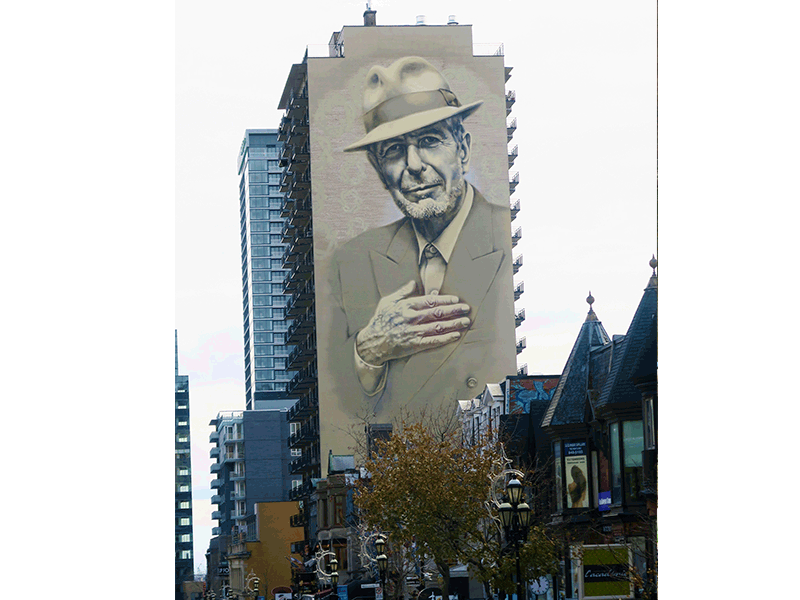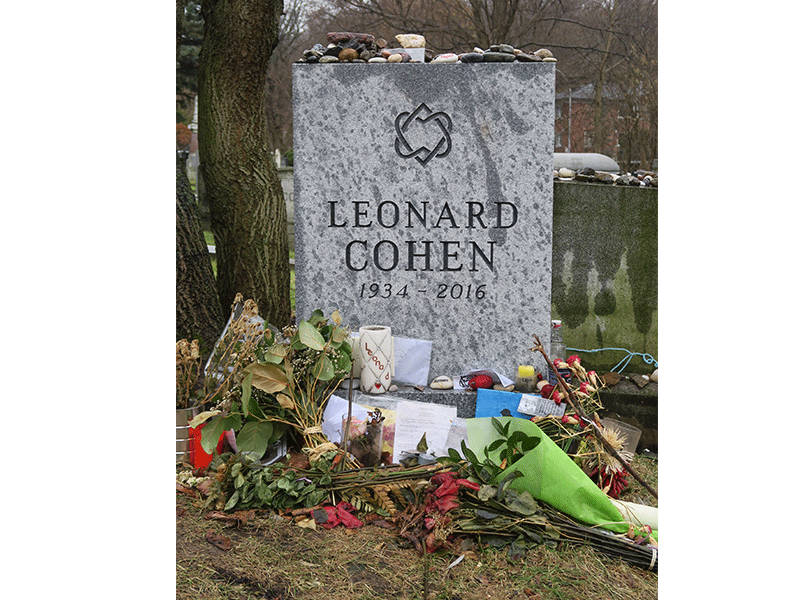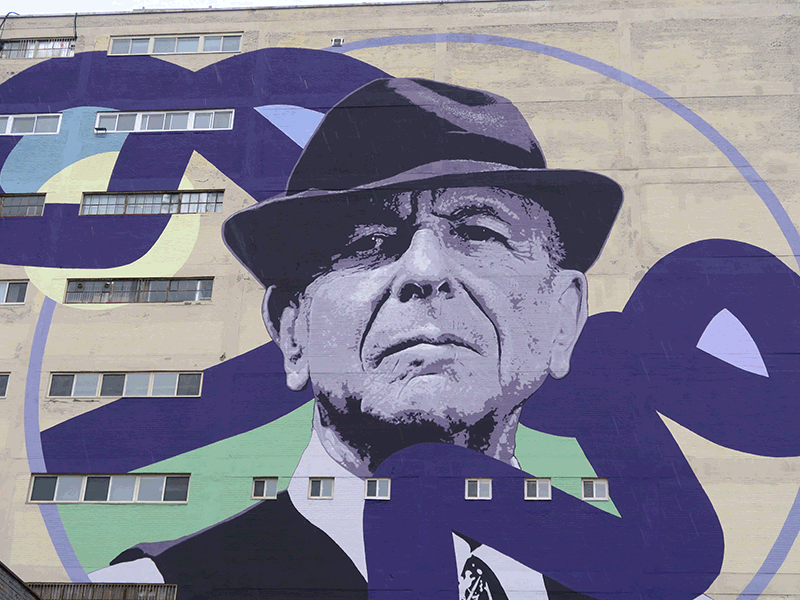When Montrealers learned that Leonard Cohen had died in Los Angeles, a crowd spontaneously gathered and sang in front of his home in the Le Plateau neighbourhood. The poet, writer and singer, had, per his wishes, been buried in a private ceremony in the Jewish Cemetery on Mont-Royal, near his parents, Masha and Nathan.
On a recent rainy Tuesday, Gilles Bengle, former director of media relations at Montreal Tourism and lifelong Leonard Cohen fan, drove me around Montreal on an unofficial Leonard Cohen tour.
You Want It Darker, Cohen’s last album, was playing on the sound system as we drove along rain-soaked streets, the familiar velvety growl seeming to sing of the overcast day. The morning after Cohen’s death became public, Bengle drove to the Plateau, stopping en route for bagels. Cutting one in half, he placed a candle inside, leaving his offering with others at Cohen’s house on Rue Vallières.
READ: WHY LEONARD COHEN WILL LIVE FOREVER
There have been many tributes to Cohen, almost too many to list: they include a pop-up karaoke event in Place des Arts metro where commuters joined in; a major concert arranged by his son, Adam, showcasing Cohen’s work; a ballet; and two gigantic murals: one, by Kevin Ledo, on Rue Napoleon off Rue St Laurent, depicts a rather serious Leonard in his old neighbourhood; the other, by Gene Pendon and El Mac, on Crescent Street, portrays a more beneficent Leonard.
A year has passed since Cohen departed this world, and his grave markers (there are two) appear in the Jewish Cemetery on Mont-Royal, adorned with stones, flowers, candles, and books. What struck me was the presence of poems by Irish poet William Butler Yeats, who, like Cohen, sang of both the spirit and the flesh well into his later years.
But most of the public will likely see Cohen at the stunning and yet intimate exhibit (20 artists, 20 musicians) that opened at MAC, Montreal’s Contemporary Art Museum in November and runs until April 9.

“A Crack in Everything”, three years in the planning, has garnered rave reviews, and is worth every minute you can spare.
“I won’t be at the opening.” Cohen’s statement about the exhibit has been widely interpreted as knowledge of his impending death. However, my surprise encounter with Robert Kory, Cohen’s Los Angeles manager, lent context to Cohen’s remarks. Giving Kory the go-ahead to plan the exhibit with MAC co-curators John Zeppetelli and Victor Shiffman, Cohen warned, “You don’t know what you’re getting into;” adding three caveats: “I won’t be at the opening. I won’t be an obstacle. If artists want to meet me, I won’t be available.” An affable man in a stylish black fedora, Kory seems more than happy with the exhibit.
Despite his public persona, Cohen was a private man. When he came to Montreal – and he came often, Bengle tells me – neighbours respected that privacy. What we see and hear in the MAC exhibit reveals Cohen the performer, the artist, the man being interviewed and adored by audiences and interpreted by a wide variety of contemporary artists.
First stop is “Passing Through” by Montrealer George Fok: almost an hour of concert footage interspersed through many decades, an experience that brings us as close to Cohen the person and performer as we could ever hope to be. “We needed to start with something immediately gripping,” says Zeppetelli, “so people will come in with a smile on their faces. He pauses before adding, “We were hoping to celebrate a living artist.”

From Ari Folman’s singular Depression Chamber to Candice Breizt’s I’m Your Man, these interpretations of Cohen’s life and work are chart-topping in their originality. Breizt’s work features 18 older men, non-singers all, speaking the words to every song on Cohen’s eponymous album, while, next door, the Shaar Hashomayim choir, from the synagogue with deep Cohen family roots, and where he was a lifelong member, sings the same songs, in tune.
A tumble of school kids is exiting one of the most intriguing installations as I enter. “I Heard There Was a Secret Chord” (by Daily tous les jours), is described as a “participatory humming experience.” Step up into a small room, hum along with Hallelujah grabbing one of several microphones hanging from the ceiling; feel the floor vibrate; then look up and see the number of people around the world now listening to that same song, gathered from live data through digital platforms.
Every visitor will have personal favourites in the show. Mine were those that made me feel close to Cohen. Immersed in concert footage and his spoken words, I experienced a curious moment when I entered a recreation of the modest study in Cohen’s L.A. home: desk, computer, artwork by a childhood friend, an ashtray with cigarette butts, a shelf of books. Looking through the window at a hologram of the actual view from the house, I heard a few cars go by and glimpsed the figure of a man very much like Cohen seated on the porch, his back to me, a cane by his chair. As I approached the window he turned and looked toward his study, hearing my footsteps, as if we might be on the verge of a conversation.
This feeling of connection with Cohen is familiar in Montreal, the place he called “the city of my heart.” Bengle had driven me past the building in the old port where his muse, Suzanne, had lived “by the river” where she gave “tea and oranges that come all the way from China” to a young poet/singer from Westmount. Our Lady of the Harbour–where “the sun pours down like honey”–still stretches out her arms in welcome at the Sailor’s Church a few streets away.
As I leave the MAC exhibit – I’ll return the following day, there’s so much to see and experience here – I remember something Robert Kory told me. “My Uber driver was a fan in Morocco as a child and now his son is a musician because he played Leonard Cohen for him.” He may not have wanted to meet with the artist-fans of his work, but it’s impossible to feel that the impeccably mannered, witty, beautifully dressed, and fundamentally kind Mr. Cohen, would not have warmed to this story.
On my last day in Montreal, as I stopped to take a picture of the Crescent Street mural, a Quebecer approached me: “C’est beau, non?” Yes, It’s beautiful.
If You Go: Montreal Tourism, www.mtl.org; MAC
